Scott Martin
Forum Master Posts: 11573
Registered: Apr 93
|
 posted 10-21-2003 07:54 AM
posted 10-21-2003 07:54 AM
  
This is a duplicate of the John Dixwell post in the American Coin Silver Forum as of October 21, 2003 at 8 Am. quote:
Topic: John Dixwell
Posted by: swarter
posted 09-17-2003 02:23 PMThe "expert opinions" discussed in the current Curators Viewpoint tea kettle thread -- Exhausted All of My Resources -- reminds me of this weeks new Antiques Roadshow From Cleveland. Did anyone see it? Someone brought in a plain vase shaped cup on a ring base and two strap handles, which she got at a flea market for $1. On the bottom, which was ringed with crude solder, were several (5-7) randomly struck, large rectangles with I-D. Their resident "silver expert" pronounced it as "an American Colonial two-handled cup, c. 1680 - 1710 by the well known silversmith John Dixwell, worth, in a well advertised auction, $1000 - 3000." (approximate quote, as best as I can remember it). Different PBS outlets show these at different times and on different days - it may screen again later this week or next. Watch for "Cleveland, Part I" - it appears early in the program. I am curious to know if others' opinions are the same as mine, which I will withhold for the moment to avoid biasing any responses. I will watch for it again, myself, to be sure I got it right the first time - some of these things can go by pretty fast.
quote:
Posted by: FredZ
posted 09-17-2003 04:00 PM
I have not have had good experiences with Mr. Boos and I do not put a great deal of creedence on his opinion.I saw the two handled cup and wished I had found such a treasure. I cannot comment on the appraisal. I thought is that it was low. I could not tell if the marks were in fact Dixwell's. Boos missed a wonderful opportunity to talk about the heritage of such a find and glosses over the particulars that you need to look at to help identify authenticity. I wish I could have looked at it more carefully. I did record this episode for my wife. Fred
quote:
Posted By: FredZ
posted 09-17-2003 10:21 PM
I have looked at the video of the Cleveland Antique Road Show and I do not believe it is by Dixwell at all.
Boos says the cup was made between 1680 & 1710. Dixwell was born in 1680 and did not begin working until 1702. Most of the work I have seen by him was marked on the side of the cups and not on the bottom. The mark on the caudle cup does not appear to be any of the marks recognized as belonging to Dixwell. All the Dixwell marks are in ovals. The marks on the Roadshow cup were in rectangles with a pellet between the I and the D. The solder job on the bottom does not bother me and is fairly typical of 17th century American work. I have not gone searching for a possible maker. The style of handle appears to be typical of 17th century silver. Any guesses? I am more likely to believe it is by Dummer than Dixwell.
Here in the Southwest I do not have access to a fine silver collection, unless I travel to The Huntington Library, and so, have not had the chance to view works by these craftsmen up close. The spoons I have in my collection were only a small portion of the silversmiths skill level and tell nothing about raising or soldering techniques. Fred
quote:
Posted by: swarter
posted 09-18-2003 01:39 PM
When first I saw the pictures of the marks, before he said "Dixwell," I said "Dummer." By the time I posted my query here, I was confident it is neither. Both Dummer and Dixwell are well documented. Fred has addressed the Dixwell marks; Dummer has only two known marks, the most widely used is larger and heart-shaped; the second is in a very small rectangle, and is very rare - Kane's list includes examples on such small objects as a finger ring and a patchbox; when used on one or two larger objects (like cups) it is in combination with the much larger, heart-shaped mark (a photo of such a piece with both marks is in Quimby). My recollection is that my impression was that the marks on the piece in question looked much too large, and the pellet was large and distinct; in Kane's photo and Currier's drawing (Currier has the most carefully drawn marks) the pellet is so indistinct as to be almost unnoticeable. The Roadshow marks might resemble more a much later and larger mark by John David, with large letters and distinct pellet (which may be too late for this piece).I also agree with Fred in regards to the mark number and placement; the usual situation shown for most published examples from this period is that there is one mark on the side, near the top of one handle (and sometimes another by the other handle on a two-handled cup), often this is a small mark on the smaller pieces. I know of a smaller, one handled cup (by another silversmith)in a private collection that has one mark by the handle, and one on the bottom, but I believe bottom marks are not the rule in this period. The random, scattered placement of the several strikes of what look to be large marks on the bottom of the Roadshow piece strike me as, at the least, very odd. Fred may have allayed my suspicions about the solder on the bottom (which I had not noticed myself, as I was concentrating on the marks, but was mentioned to me by my wife, and relayed by email to Fred who kindly reviewed his tape), but I still have other questions. Let's have some other comments. This is still a developing story.
quote:
Posted By:FredZ
posted 09-18-2003 11:24 PM
I have looked at the video of the cup on the Roadshow and I have made several notes on what I observed. The shape is not like most caudle cups even of the 18th century. The sides of the cup are fairly straight and do not curve into the body before flaring out on the edge. The proportions are not bad. I can not find a match to the handles on any early American silver of any period. The most suspicious is the method that the foot is applied to the body. It looks as if the foot is flared into the body. I have not examined any period cups to tell if this is common. I looked for the kernel on the bottom of the body of the cup and did notice a small notch off the center most maker's mark. We have no images of the inside of the cup so we are not able to tell if the bottom was married to the base at a later date. The marks appear to be the same except for the fifth mark along the edge. I could swear it looks substantially smaller than the other four. Fred
quote:
Posted by: swarter
posted 09-20-2003 04:49 PM
Thanks to Fred, I have now gotten a second look at the cup in images taken from his tape of the Roadshow. Typical caudle cups of the period are squat, bulbous affairs, narrowed or "necked" below a straight or only slightly flared lip. The Roadshow cup is of similar proportions, but has a pronounced flare at the lip, a slightly tapered body rounded at the bottom, but not swollen, and no constriction. The handles are not simple straps, nor do they appear cast; what is striking about them is a marked asymmetry, when only a slight but noticeable asymmetry would be expected in matching hand made handles - it is almost as if this piece began life as a one-handled teacup-like vessel to which a second handle was later added.There are four large marks on the bottom, and one small one. The reserves are rectangular, rather than oval, and therefore are not Dixwell's. The letters in the small mark are closer together than those in Dummer's one recognized initial mark; he has no published recognized large one. So far, none of us who has been corresponding by email about this interesting object has yet come up with an image of a caudle cup by Dummer, Dixwell, or another contemporary that closely resembles this piece. If anyone finds one, please email or post it here.
quote:
Posted by: wev
posted 09-21-2003 12:09 PM
Here are some pictures of the cup in question -- the quality is iffy, but the best I could manage from tv screen shots:
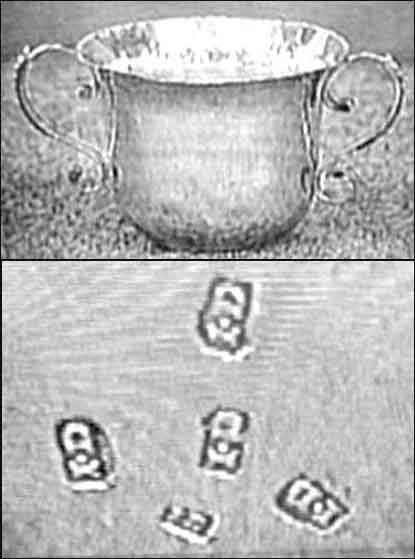 And a splice to compare the handles:
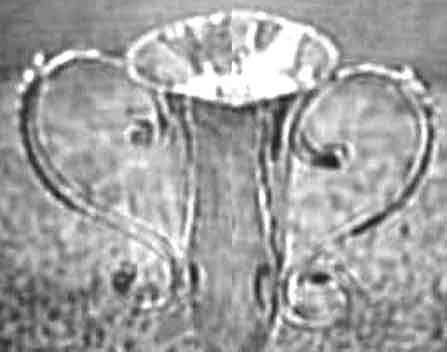
quote:
Posted by:Scott Martin
posted 09-21-2003 02:29 PM
WEV, Thanks for the photos. They are very helpful.
quote:
Posted by: swarter
posted 09-21-2003 04:11 PM
Here are some pieces by Jeremiah Dummer:
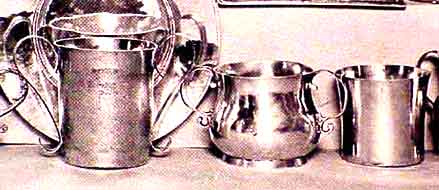
2-handled cup, caudle cup, and beaker.And here are cups and beakers by John Dixwell:
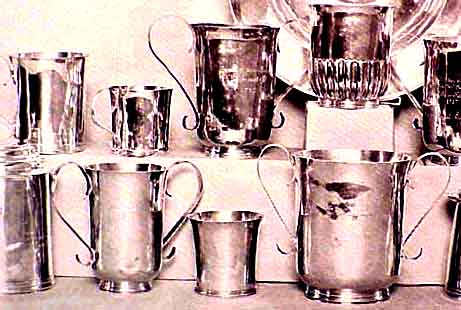
quote:
Posted by: Brent
posted 09-21-2003 06:47 PM
If I had to guess, I would say that this is an English Georgian or Victorian reproduction cup with a second handle added later. I would say that the four larger marks are struck over genuine English hallmarks, and the small I*D is the actual English maker's mark. The mark furthest to the left definitely looks like an overstrike.Interestingly, if I am correct Mr. Boos' monetary appraisal is probably about right for the item in question. If it really were by Dixwell or Dummer, he would be off by at least an order of magnitude. A poor appraisal, regardless. Brent
quote:
Posted by: swarter
posted 09-21-2003 08:21 PM
Brent, I think you are correct about the overstamps. The irregular outlines of the large stamps probably does indicate that. The uppermost one seems to have been of different shape the one on the left, which may have been an oval mark. In addition, the center one seems to have a centerpunch adjacent to it, which indicates that the piece was raised from a single blank of silver and the bottom is not set in - I had thought the latter a possibility because I had been told that the solder on the bottom ring might have looked too sloppy. Not long ago I had seen on ebay a later 18th Century (2nd half) marked English piece of similar style, except that it had plain strap handles. I was thinking of a replaced bottom on a similar object, but overstamping seems more logical. Two questions now remain - who did the overstamping, and why? An English piece could not have been resold in England without hallmarks, and there are none remaining on this piece. Was this a resale (or repair, which might also explain the asymmetrical handles) marked by a legitimate, but later, silversmith (perhaps in America), or is it a blatant attempt at a forgery? Did someone fabricate a punch and overstamp either a legitimate old or reproduction piece with the clear intent to deceive? It has happened before.
quote:
Posted by: Brent
posted 09-22-2003 12:25 AM
Good question. My gut reaction is that this was a rather crude attempt to make a run-of-the-mill English piece into a rare and valuable early American cup, with clear intent to deceive. The fakes collected by Hollis French (which, coincidentally (or maybe not?) are at the Cleveland Museum of Art), as well as the enormous collection of fakes donated to Winterthur, show a broad range of techniques, both convincing and otherwise. This one seems rather straightforward, but should not have convinced anyone. Maybe the Cleveland Museum jettisoned it?Brent
quote:
Posted by: swarter
posted 10-20-2003 05:47 PM
One mystery is now solved, only to be replaced by another:While looking for something else, I have come across some identical pieces illustrated in Channel Islands Silver by Richard Mayne, in which are pictured some 13 examples by 5 silversmiths of what are apparently characteristic Guernsey Island christening cups. Those which bear dates were marked or engraved between 1776 and 1785. One is attributed to a smith who was working earlier in the Century, while the periods of the other four encompass these dates. According to Mayne, some 20 examples exist of these cups which bear either London hallmarks, or maker's marks of another Guernsey silversmith, that have been overstamped with an I-D mark identical to that on the Roadshow cup. It is thought that those cups with overstamped hallmarks had been locally made, sent to London for assay, and for some reason returned to Guernsey only to be overstamped by a local silversmith, Jean Pierre du Port, who worked from 1779 to 1788, and who apparently is known to have made such cups. Below is a copy of a plate from Channel Islands Silver (copyright 1985 by Richard Mayne) showing three christening cups by Jean Pierre du Port, and the bottom of one bearing overstamped London hallmarks (note the incuse duty mark used only in 1784 and 1785): 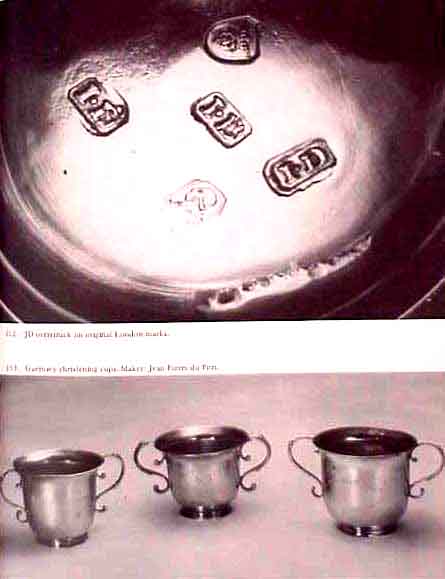 QUOTE:
---------------------------------------------------------------
Two questions now remain - who did the overstamping, and why?
--------------------------------------------------------------- So we can confirm that the cup is a legitimate Georgian piece, and we now know who did the overstamping, but not why the the cup was sent to England and returned, only to have its hallmarks overstamped.
IP: Logged |

 SMP Silver Salon Forums
SMP Silver Salon Forums

 British / Irish Sterling
British / Irish Sterling

 John Dixwell
John Dixwell







